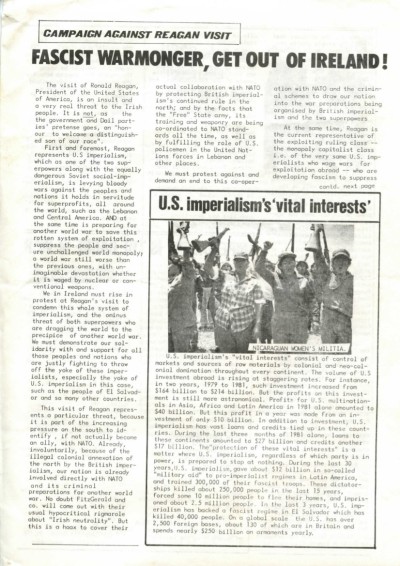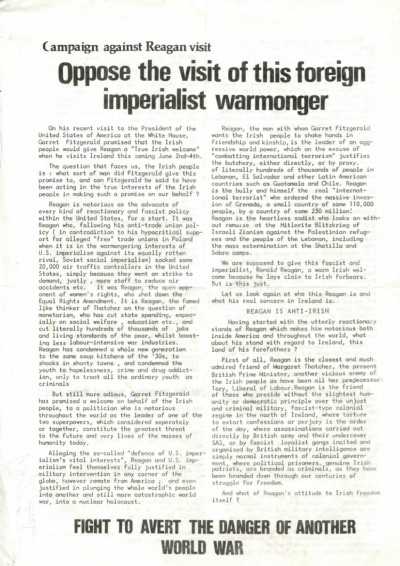1979
The Wood Quay Occupation began
On the 1st of June 1979, a group of protestors began an occupation of the development at Wood Quay, as part of the campaign to preserve the historical mediaeval site from destruction. Dubbed “Operation Sitric”, after Sigtrygg Silkbeard, a Hiberno-Norse King of Dublin, the occupation lasted for three weeks.
![Drama and uncertainty surrounded the room in the Liberties where a group of famous people met to carry out the invasion of the Wood Quay site. And what a picture they made -- an alderman in his robes, well known writers, politicians and trade union leaders.
The plan was well worked out -- every move on the site had been observed and recorded for days and when the unsuspecting foreman drove his car as usual through the main gate at Winetavern St. the task force struck. It was split second timing -- and the security staff were left open mouthed as a nun and a priest lef the group in. The Alsation dogs were safely in their kennels awaiting release -- they were padlocked. Then down the hill from Christ Church came the second wave in their robes and ribbons. A squad car was parked outside but the stunned gardi [sic] were glued to their seats with surprise at the glittering parade of famous names: Mary Lavin, James Plunkett, Michael O'Leary, Denis Larkin, Donal Nevin, Oisín Kelly, Gemma Hussey, Alexis Fitzgerald, Kevin Byrne, George Eogan, John Gallagher, Benvenuta MacCurtain, Imogen Stuart, Michael Scott, Tom Kinsella and F.X. Martin.
Immediately the security boss approached Fr. Martin to be informed of the peaceful occupation. He accepted the accomplished fact and related "Oh, Fr. Martin, sure I know you well. You lectured me in History." The manning of the gates and the crucial task of locking up the guard dog kennel followed. After this Tom Kinsella read the proclamation "A Statement to the Citizens of Dublin".](/image/4/1200/1200/images/inline/wqn1.png)
You can find more material from the Wood Quay campaign in the Wood Quay Protests collection.
![Silence is violence
Nearly seven hundred delegates at the Labour Party Conference voted for a composite motion which called for a boycott of functions and engagements held in connection with President Reagan’s Irish visit. The international committee advocated a similar approach. However, it was defeated by the narrowest of margins.
Speakers from what may be termed the party’s ‘centre’ argued against a boycott. Senators O’Mahoney and Harte having condemned torture, mass murder,violations of international law, the attempts to overthrow a legitimate government (one that is supported by the Socialist International) and all criminal activities sponsored by the Reagan Administration, then turned around and said a boycott wouldn’t look good or was contrary to ‘protocol’. They of course were to later absolve their socialist conscience by personally boycotting the joint session but had helped block Labour taking effective action as a party. This position might be characterised as leading from behind. A majority of the score or more parliamentarians who boycotted Reagan’s Oireachtas speech were Labour Party representatives, yet because we did not lead from the front, a course advocated by the Left and one which would have brought attention to our internationalist philosophy, we failed to offer genuine, as opposed to token, solidarity with the oppressed in the Third World.
At Conference the leadership were given a lifeline in the form of a petition to be given to Reagan which replaced the boycott. Dick Spring we are told fulfilled his obligations in this regard although predictably this exercise did not receive any headlines or photographs nor was it meant to. Spring neither led from the front nor behind but rather played second fiddle to the host, Garret FitzGerald.
Given that nearly 50% of Party wanted a complete boycott and an overwhelming majority showed grave concern at Reagan’s policies one would have expected Spring to give public expression of this anger. Instead his contributions to this media event was laughing and joking with Nancy Reagan at the State Banquet while hundreds of party members marched together outside with thousands of others.
Once again the leadership proved incapable of giving expression to the concerns, aspirations and idealism of young people. Another opportunity missed.
[Image shows a number of people marching in Dublin with the foreground banner reading "Silence is violence". It is captioned: Protesters at anti-Reagan demo.]](/image/4/1200/1200/images/inline/labour_left-reagan.png)


